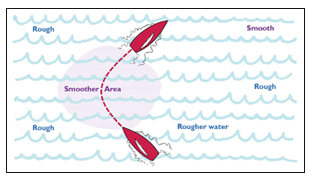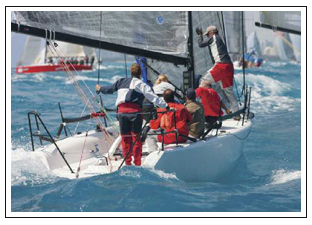|
Tacking and jibing in waves
 The first, and by far the most important
thing about tacking in waves is
that you should try not to do it. Tacking
is costly enough under the best circumstances,
but when you make a maneuver
like this in choppy water you lose a lot.
The first, and by far the most important
thing about tacking in waves is
that you should try not to do it. Tacking
is costly enough under the best circumstances,
but when you make a maneuver
like this in choppy water you lose a lot.
Of course, many races are sailed in
rough seas and you have to tack somewhere!
In that case your goal is to find
spots that are relatively smooth (see
right) so you lose as little distance as
possible relative to your competition.
One of the best strategies for a successful
maneuver in waves is to tack
when you want to, not when you have
to. If you decide to leebow a starboard
tacker, for example, you must turn in
one particular spot, and thatís slow if
the waves happen to be bad there. Abetter
strategy is to sail the beats so you
can tack when and where you want to
since the distance you gain by tacking in
flatter water can be significant.
Though waves are bad for tacking,
they can actually be very good for jibing.
While you are surfing down a
wave, the boat is stable with less wind
pressure in the sails. But in light wind,
waves make it harder to keep flow
attached to the sails and to accelerate
after the jibe.
Executing a good tack in waves
When you are considering a tack in bumpy conditions, make sure you plan ahead! In flat
water you can make a fast tack anywhere on the race course, but in waves you have many
fewer chances. Look for a relative flat spot ahead and to windward (roughly 30į off your
bow), making sure you will have at least a short distance to accelerate on the new tack
before hitting any big waves. Since the helmsperson has to make the call about exactly
when and how to turn the rudder, it is essential that he or she has a clear view of the water
ahead. Here are some other tips:
 ē Make sure you have good speed before you tack Ė One of the worst things you can
do is to tack when you are not going full speed upwind. So donít tack during a lull, while
you are pinching or just after hitting a set of bad waves. In many cases itís actually better
to be going slightly faster than normal when tacking.
ē Make sure you have good speed before you tack Ė One of the worst things you can
do is to tack when you are not going full speed upwind. So donít tack during a lull, while
you are pinching or just after hitting a set of bad waves. In many cases itís actually better
to be going slightly faster than normal when tacking.
ē Turn a little faster than usual Ė The slower you turn through a tack, the bigger your
chance of hitting a bad wave in mid-tack (the worst time to hit a wave). So speed up your
rate of turn slightly, especially the part of the tack where your are head to wind since this
is when your hit the waves most squarely.
ē Turn a little farther than usual Ė When you come out of the tack youíll need extra
power to accelerate in the waves, so make sure you come out a little Ďfatí (slightly footing)
rather than a little Ďthiní (slightly pinching).
Jibe while surfing!
These sailors are hoisting their spinnaker, but this would also
be a good place to jibe. When itís windy, jibe when you are
surfing down a wave (i.e. when your stern is higher than your
bow and the boat is sliding downhill). The speed you gain
when surfing on a wave will decrease your apparent wind
pressure, unload your sails and make the boat more stable.
While flat water is a good place to tack, itís not so great
for jibing in breezes because you canít unload the pressure
on your sail plan. Thatís one reason why waves are your
friends downwind. But if thereís not enough wind for surfing,
itís probably better to make your jibe in flatter water, too,
since it will be easier to maintain and build speed that way.]
In any case, be patient until you find a good place to jibe.
Once you do, be decisive and go for it. Hesitation often leads
to disaster.
Dave publishes the newsletter Speed & Smarts. For
a subscription call: 800-356-2200 or go to:
www.speedandsmarts.com
TOP
|